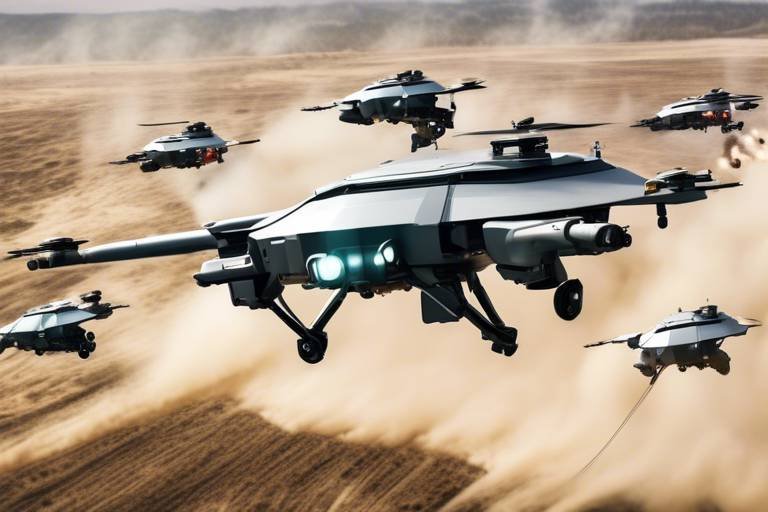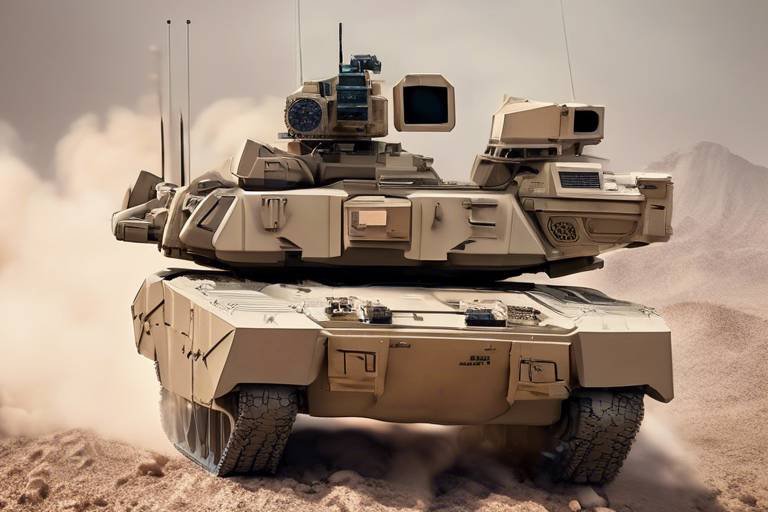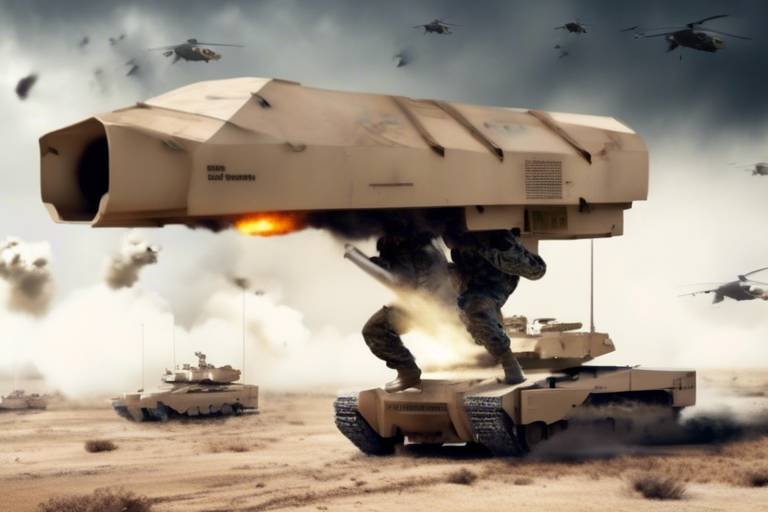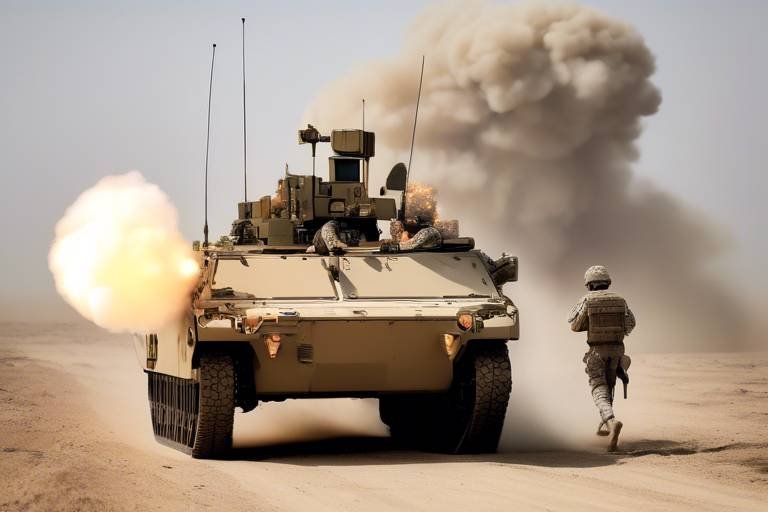How Advanced Defense Systems Address Emerging Security Challenges
In today's world, the landscape of security threats is constantly evolving, and the implications are profound. From cyber attacks that can cripple critical infrastructure to the persistent threat of terrorism and conventional warfare, nations are under pressure to adapt and innovate. This is where advanced defense systems come into play, acting as a shield against these multifaceted challenges. But what exactly are these systems, and how do they work? Let's dive deeper into the realm of defense technology and explore the innovations that are essential for tackling contemporary security threats.
Advanced defense systems are not just about military might; they encompass a wide array of technologies and strategies designed to protect nations and their citizens. Imagine a fortress, but instead of stone walls, it’s built with cutting-edge technology. These systems include everything from sophisticated missile defense systems to cybersecurity frameworks that safeguard sensitive information. By understanding these systems, we can better evaluate their effectiveness in the modern security landscape.
One of the most exciting aspects of advanced defense systems is the integration of artificial intelligence (AI). AI has become a game-changer in military operations, enabling faster decision-making and predictive analytics. Picture a chess grandmaster who can foresee moves several steps ahead; that's the kind of strategic advantage AI offers to military planners. With autonomous operations becoming more prevalent, the effectiveness of military strategies against emerging threats has significantly improved.
Moreover, machine learning applications are enhancing threat detection and response capabilities. These systems can analyze vast data sets in real-time, identifying potential security breaches and vulnerabilities before they can be exploited. This proactive approach is akin to having a security guard who doesn’t just react to incidents but anticipates them, ensuring a safer environment for all.
Autonomous systems, including drones and unmanned vehicles, are revolutionizing military operations. They provide critical capabilities such as surveillance and reconnaissance without putting human lives at risk. Imagine sending a robot into a dangerous zone instead of a soldier; it’s a significant shift in how we approach military engagements. These systems not only enhance operational efficiency but also save lives, making them an essential component of modern defense strategies.
As we navigate the complexities of modern warfare, cybersecurity measures have become increasingly vital. With cyber threats growing more sophisticated, advanced defense systems are incorporating robust cybersecurity frameworks to protect critical infrastructure and sensitive data. It’s like having a digital fortress that guards against invisible enemies lurking in the shadows of the internet.
However, addressing these emerging security challenges isn't a solo endeavor. International collaboration plays a crucial role in enhancing collective defense capabilities. Nations are coming together to share intelligence, technology, and resources, creating a united front against common threats. Think of it as a global alliance where countries pool their strengths to tackle security issues more effectively.
Joint military exercises among allied nations strengthen interoperability and readiness. These collaborative efforts ensure that defense systems can work seamlessly together in response to shared security threats, much like a well-rehearsed orchestra performing a symphony. When every instrument knows its part, the result is a harmonious and effective response to crises.
Intelligence sharing initiatives foster cooperation between countries, enabling them to anticipate and counter emerging security challenges. In a world where information is power, sharing insights can make all the difference. It’s like having a network of friends who keep each other informed about potential dangers, enhancing everyone's safety.
Despite the advancements in advanced defense systems, challenges remain. Budget constraints often limit the development and deployment of these technologies, forcing governments to prioritize certain programs over others. This can leave gaps in national security, akin to patching up a leaky roof with only a few tiles. Each missing piece can create vulnerabilities that adversaries might exploit.
Furthermore, the use of advanced technologies in defense raises ethical considerations. The development of autonomous weapons and surveillance systems necessitates a careful examination of their implications for human rights and international law. Are we crossing a line that could lead to unintended consequences? It’s a question that policymakers must grapple with as they navigate the future of defense.
- What are advanced defense systems?
Advanced defense systems are a combination of technologies and strategies designed to protect nations from evolving threats such as cyber attacks, terrorism, and conventional warfare. - How does artificial intelligence improve defense systems?
AI enhances decision-making, predictive analytics, and autonomous operations, significantly improving military strategies against emerging threats. - Why is international collaboration important in defense?
International collaboration allows nations to share intelligence and resources, creating a united front against common security challenges. - What challenges do advanced defense systems face?
Challenges include budget constraints, technological limitations, and ethical considerations regarding the use of advanced technologies in warfare.

Overview of Advanced Defense Systems
Advanced defense systems are the backbone of modern military strategy, designed to tackle a myriad of evolving threats that nations face today. In a world where cyber attacks, terrorism, and conventional warfare are on the rise, understanding these systems is not just beneficial, but essential. These systems incorporate a variety of technologies and strategies that work in tandem to protect national interests and ensure global safety.
At the core of advanced defense systems lies the integration of multiple technologies. This fusion creates a robust framework capable of responding to threats that are increasingly sophisticated and unpredictable. For instance, nations are now investing heavily in artificial intelligence (AI) and machine learning to enhance their surveillance capabilities. These technologies allow for real-time data analysis, enabling defense agencies to anticipate potential threats before they escalate into crises.
Moreover, the advent of unmanned aerial vehicles (UAVs), commonly known as drones, has revolutionized military operations. These autonomous systems provide critical advantages in surveillance and reconnaissance, allowing for missions to be conducted without putting human lives at risk. The ability to gather intelligence from hard-to-reach areas has become a game changer in modern warfare.
It's also important to recognize the role of cybersecurity within advanced defense systems. As our reliance on technology grows, so does the vulnerability to cyber threats. Nations are now prioritizing the protection of their critical infrastructure and sensitive information through sophisticated cybersecurity measures. This includes everything from firewalls and encryption to advanced threat detection systems that can identify and neutralize attacks before they cause damage.
In light of these advancements, it is evident that advanced defense systems are not simply about brute force; they are about smart, strategic responses to complex threats. The integration of technology and international collaboration is crucial in fortifying these systems, enabling nations to work together to address common security challenges. This collaborative approach not only enhances individual national capabilities but also contributes to global stability.
In summary, the landscape of advanced defense systems is ever-evolving, shaped by technological innovations and the pressing need for nations to protect themselves against a variety of threats. As we delve deeper into the specifics of these systems, we will uncover the technologies that are redefining defense strategies and their implications for our collective safety.

Key Technologies in Defense Systems
In today's rapidly changing world, the evolution of defense technologies is not just a trend; it's a necessity. As nations face a myriad of threats—from cyber warfare to conventional military confrontations—their defense systems must be equipped with cutting-edge technologies that can adapt and respond effectively. The backbone of these advanced defense systems comprises several key technologies that work in concert to enhance national security. Among these, artificial intelligence (AI), drones, and missile defense systems stand out as pivotal components.
Artificial intelligence is revolutionizing how defense operations are conducted. By leveraging AI, military strategists can analyze vast amounts of data in real-time, allowing them to make informed decisions faster than ever before. Imagine a scenario where a military commander can predict potential threats before they even materialize—this is the power of AI in defense. Moreover, AI systems can learn from past incidents, continuously improving their predictive capabilities. This not only enhances the effectiveness of military strategies but also minimizes risks to personnel.
Within the realm of AI, machine learning plays a crucial role. By utilizing algorithms that can learn and adapt, defense systems are able to enhance their threat detection and response capabilities. For instance, machine learning can analyze patterns in data to identify potential security breaches, allowing for proactive measures to be taken. This is particularly important in an age where cyber threats are becoming increasingly sophisticated.
Furthermore, autonomous systems, including drones and unmanned vehicles, are changing the landscape of military operations. These technologies provide critical capabilities such as surveillance, reconnaissance, and even combat, all while keeping human lives out of harm's way. The ability to deploy drones for missions in hostile environments reduces the risk to personnel, making military operations not only safer but also more efficient. Drones can gather intelligence in real-time, providing commanders with up-to-date information that can be crucial for decision-making.
Missile defense systems also form a vital part of advanced defense technologies. With the increasing threat of missile attacks from rogue states or terrorist organizations, nations are investing heavily in systems designed to detect and intercept incoming threats. These systems often utilize a combination of radar technology and advanced interception techniques to neutralize potential dangers before they reach their targets. The integration of AI into these systems further enhances their effectiveness, allowing for faster reaction times and improved accuracy.
| Technology | Function | Benefits |
|---|---|---|
| Artificial Intelligence | Data analysis and decision-making | Faster response times, improved predictive capabilities |
| Drones | Surveillance and reconnaissance | Reduced risk to personnel, real-time intelligence gathering |
| Missile Defense Systems | Detection and interception of missiles | Protection against missile threats, enhanced national security |
As we delve deeper into the realm of advanced defense systems, it's essential to recognize that these technologies are not just standalone solutions. They are part of an integrated approach to security that combines various elements to create a robust defense mechanism. The synergy between AI, autonomous systems, and missile defense systems exemplifies how technology can be harnessed to address contemporary security challenges effectively.
- What is the role of AI in defense systems? AI enhances decision-making, predictive analytics, and operational efficiency in military strategies.
- How do drones contribute to national security? Drones provide surveillance and reconnaissance capabilities while minimizing risks to human lives.
- What are missile defense systems? These systems are designed to detect and intercept incoming missile threats, ensuring national safety.

Artificial Intelligence in Defense
In today's ever-evolving landscape of security threats, artificial intelligence (AI) has emerged as a game changer in the realm of defense. Imagine having a super-smart assistant that can analyze mountains of data in the blink of an eye, making decisions faster than any human could. That's precisely what AI brings to the table. It enhances military strategies by enabling faster decision-making, offering predictive analytics, and facilitating autonomous operations. This powerful technology allows defense systems to adapt and respond to emerging threats with unprecedented agility.
One of the most exciting aspects of AI in defense is its ability to sift through vast amounts of information. For instance, consider a scenario where a nation faces a potential cyber attack. With AI's predictive capabilities, it can analyze patterns and detect anomalies in real-time, alerting defense personnel before a breach occurs. This proactive approach is crucial for safeguarding national security and ensuring that defense mechanisms are always one step ahead of adversaries.
Moreover, AI enhances operational efficiency through autonomous systems. Drones and unmanned ground vehicles are now equipped with AI algorithms that allow them to operate independently, conducting reconnaissance missions or carrying out strikes without direct human intervention. This not only saves lives but also provides a tactical advantage by allowing military forces to gather intelligence or engage in combat in high-risk environments without putting personnel in harm's way.
To illustrate the impact of AI in defense, let’s look at a few key areas where it has made significant strides:
- Threat Detection: AI systems can analyze data from various sources, including satellite imagery and social media, to identify potential threats before they escalate.
- Logistical Support: AI optimizes supply chains and resource allocation, ensuring that military units are well-equipped and ready for operations.
- Training Simulations: AI-driven simulations provide realistic training environments for military personnel, enhancing their readiness for real-world scenarios.
However, while the integration of AI in defense systems presents numerous advantages, it also raises some important questions. For example, how do we ensure that AI systems operate ethically and do not make decisions that could lead to unintended consequences? As we continue to harness the power of AI, it is critical to establish guidelines and frameworks that govern its use in military applications.
In conclusion, the role of artificial intelligence in defense cannot be overstated. It is not just a tool; it is a transformative force that is reshaping how nations approach security challenges. As we look to the future, the ongoing development and implementation of AI technologies will undoubtedly play a pivotal role in enhancing national defense capabilities and ensuring global safety.

Machine Learning Applications
Machine learning is transforming the landscape of defense systems, providing a robust framework for enhancing threat detection and response capabilities. By leveraging algorithms that can learn from and make predictions based on data, military organizations can analyze vast amounts of information in real-time. This capability is crucial in identifying potential security breaches and vulnerabilities before they escalate into significant threats.
One of the most compelling aspects of machine learning in defense is its ability to improve situational awareness. Imagine a scenario where a military base is under constant surveillance. Traditional methods might involve human operators monitoring feeds from various cameras and sensors, which can be overwhelming and prone to human error. However, with machine learning, systems can automatically analyze video feeds and sensor data, flagging unusual activities or patterns that might indicate an impending threat. This not only speeds up the response time but also allows human operators to focus on strategic decision-making rather than sifting through data.
Moreover, machine learning applications can be categorized into several key areas within defense systems:
- Predictive Maintenance: By analyzing data from equipment sensors, machine learning algorithms can predict when a piece of military hardware is likely to fail, allowing for timely maintenance and reducing downtime.
- Cyber Threat Detection: Advanced algorithms can detect anomalies in network traffic, identifying potential cyber threats before they can cause damage.
- Intelligence Analysis: Machine learning can process and analyze vast amounts of intelligence data, helping analysts identify trends and make informed decisions faster.
These applications demonstrate the versatility of machine learning in defense, showcasing its potential to enhance operational efficiency and effectiveness. However, the integration of machine learning into defense systems is not without its challenges. Issues such as data privacy, algorithmic bias, and the need for robust cybersecurity measures must be addressed to ensure that these technologies are used responsibly and effectively.
In summary, machine learning applications in defense systems are revolutionizing how military operations are conducted. By enabling real-time data analysis and improving decision-making processes, these technologies are essential for maintaining national security in an increasingly complex threat landscape.
What is machine learning in defense systems?
Machine learning in defense systems refers to the use of algorithms that can learn from data to improve decision-making, threat detection, and operational efficiency.
How does machine learning enhance threat detection?
Machine learning enhances threat detection by analyzing large volumes of data in real-time, identifying unusual patterns or anomalies that may indicate potential security threats.
What are some challenges associated with machine learning in defense?
Challenges include data privacy concerns, algorithmic bias, and the need for strong cybersecurity measures to protect sensitive information.
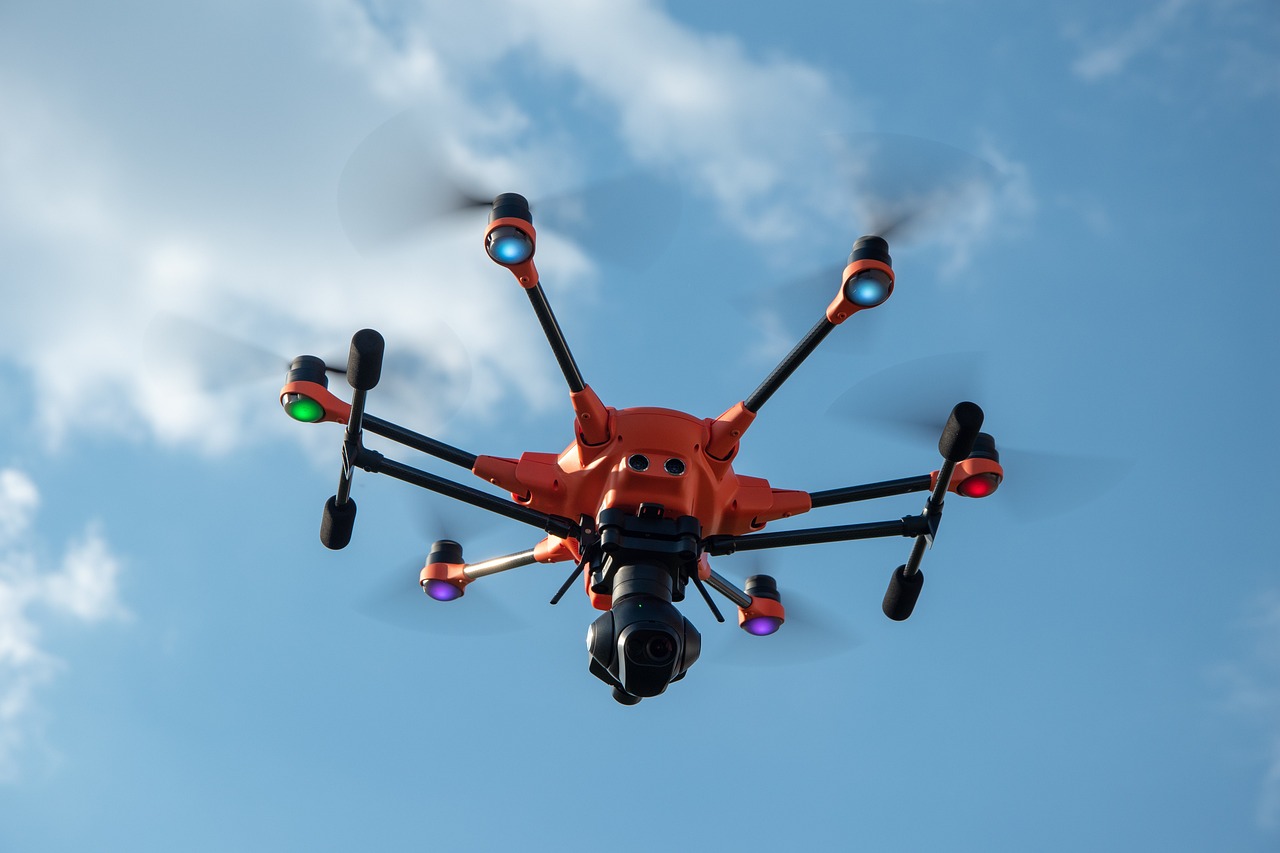
Autonomous Systems
Autonomous systems are rapidly transforming the landscape of military operations, acting as game-changers in how nations approach defense. Imagine a world where drones can fly missions without a pilot, or unmanned ground vehicles can navigate hostile terrain to gather intelligence. This isn't science fiction—it's happening right now! These systems not only enhance operational capabilities but also significantly reduce the risk to human life in dangerous situations.
One of the most exciting aspects of autonomous systems is their ability to perform tasks that are typically dangerous or impossible for human soldiers. For example, unmanned aerial vehicles (UAVs) can conduct surveillance missions over enemy territory without putting pilots in harm's way. These drones can be equipped with advanced sensors and cameras, allowing them to gather crucial intelligence while maintaining a safe distance. In many cases, they can even be deployed in environments that are too hazardous for human personnel, such as disaster-stricken areas or chemical spill sites.
Moreover, the integration of artificial intelligence into these systems enhances their functionality. AI algorithms allow autonomous vehicles to make real-time decisions based on the data they collect. For instance, if a drone detects an unexpected movement in a restricted area, it can analyze the situation and decide whether to engage, retreat, or call for backup. This level of responsiveness is invaluable in modern warfare, where the speed of decision-making can mean the difference between success and failure.
However, with great power comes great responsibility. The deployment of autonomous systems raises important ethical questions. For instance, should machines be making life-and-death decisions on the battlefield? Who is accountable if an autonomous drone mistakenly targets civilians? These questions are not just theoretical; they are critical to shaping future policies and regulations governing the use of such technologies. As nations continue to invest in autonomous systems, it is essential to strike a balance between leveraging their advantages and addressing the ethical implications they present.
In conclusion, autonomous systems are revolutionizing military operations by providing capabilities that were once thought impossible. They increase efficiency, reduce risks to human lives, and enhance the effectiveness of defense strategies. As we move forward, it is crucial to navigate the complex ethical landscape that accompanies these innovations, ensuring that they are used responsibly and in alignment with international law.

Cybersecurity Measures
As we navigate through an era where technology is both a boon and a bane, the importance of in advanced defense systems cannot be overstated. With the rise of sophisticated cyber threats, nations are compelled to innovate and bolster their defenses against potential attacks that could cripple critical infrastructure or compromise sensitive information. Imagine a world where a single cyber breach could halt power grids, disrupt financial systems, or even manipulate military operations—it's a reality that many countries are striving to prevent.
To combat these threats, advanced defense systems are integrating a multitude of cybersecurity strategies designed to safeguard against intrusions. These measures often include:
- Intrusion Detection Systems (IDS): These systems monitor network traffic for suspicious activity and potential threats, alerting security personnel to take immediate action.
- Firewalls: Acting as a barrier between trusted internal networks and untrusted external networks, firewalls help filter incoming and outgoing traffic to prevent unauthorized access.
- Encryption: This process secures data by transforming it into a code that can only be deciphered by those who possess the correct key, ensuring that sensitive information remains confidential.
- Regular Security Audits: Conducting periodic reviews of systems and networks helps identify vulnerabilities and address them before they can be exploited.
Furthermore, the implementation of artificial intelligence in cybersecurity cannot be overlooked. AI algorithms can analyze vast amounts of data at lightning speed, identifying patterns that may indicate a security breach. This capability not only enhances threat detection but also allows for predictive analytics, enabling defense systems to anticipate potential attacks before they occur. It’s like having a crystal ball that reveals the intentions of cybercriminals, allowing for preemptive measures.
Another critical aspect of cybersecurity measures is the emphasis on training and awareness. Personnel involved in defense systems must be well-versed in the latest cybersecurity protocols and threats. Regular training sessions can equip them with the skills necessary to recognize phishing attempts, social engineering tactics, and other common cyber threats. After all, the human element is often the weakest link in the security chain, and educating staff can significantly reduce vulnerabilities.
In addition to these technologies and training programs, collaboration between nations plays a significant role in enhancing cybersecurity measures. By sharing intelligence on emerging threats and best practices, countries can create a more resilient defense against cyber attacks. Global partnerships foster a collective approach to cybersecurity, ensuring that no nation is left to fend for itself in this complex digital landscape.
In conclusion, the integration of robust cybersecurity measures within advanced defense systems is essential for safeguarding against the ever-evolving landscape of cyber threats. As technology continues to advance, so too must our strategies for defending against potential attacks. The stakes are high, and the time to act is now.
- What are advanced defense systems? Advanced defense systems refer to a range of technologies and strategies designed to protect nations from various security threats, including cyber attacks, terrorism, and conventional warfare.
- How does artificial intelligence enhance cybersecurity? AI enhances cybersecurity by enabling faster threat detection, predictive analytics, and automating responses to potential security breaches.
- Why is international collaboration important in cybersecurity? International collaboration allows nations to share intelligence, resources, and best practices, creating a more comprehensive defense against cyber threats.
- What are some common cybersecurity measures? Common measures include intrusion detection systems, firewalls, encryption, and regular security audits.

The Role of International Collaboration
In today’s interconnected world, the notion of national security extends far beyond a country’s borders. It has become increasingly clear that addressing global security challenges requires a concerted effort among nations. International collaboration plays a pivotal role in enhancing defense capabilities and ensuring that countries are better prepared to face a myriad of threats, from terrorism to cyber attacks. By pooling resources, sharing intelligence, and conducting joint operations, countries can create a more robust defense posture that benefits all involved.
One of the most effective ways nations collaborate is through joint military exercises. These exercises not only improve the interoperability of different armed forces but also foster camaraderie and understanding among military personnel. Imagine a scenario where forces from multiple countries come together to simulate a crisis situation. This real-time collaboration helps to identify strengths and weaknesses in each nation’s defense strategies. As a result, when an actual threat arises, these nations can respond more effectively. The importance of such exercises cannot be overstated, as they serve as a practical training ground for the complexities of modern warfare.
Moreover, intelligence sharing initiatives have become a cornerstone of international defense collaboration. Countries that share intelligence can anticipate threats more accurately and respond with agility. For example, if one nation detects unusual cyber activity, sharing that information with allies can help prevent a larger attack. This kind of proactive approach not only protects individual nations but also strengthens global security. To illustrate the significance of intelligence sharing, consider the following table:
| Country | Type of Intelligence Shared | Impact on Security |
|---|---|---|
| USA | Cyber Threat Intelligence | Prevention of major cyber attacks |
| UK | Counterterrorism Data | Disruption of planned attacks |
| Australia | Military Strategy Insights | Enhanced operational readiness |
While the benefits of international collaboration are clear, it is essential to acknowledge the challenges that come with it. Differences in national policies, communication barriers, and varying levels of technological advancement can complicate cooperative efforts. However, these obstacles can be overcome through dedicated diplomacy and a shared commitment to global security. By fostering a culture of trust and openness, nations can work together more effectively, ensuring that they are prepared to face any threat that may arise.
In conclusion, the role of international collaboration in defense cannot be underestimated. As threats continue to evolve, so too must our strategies for addressing them. By embracing cooperation, countries can build a formidable alliance that not only enhances their own security but also contributes to a safer world for everyone. The future of global defense relies on the ability of nations to come together, share knowledge, and act in unison against common threats.
- Why is international collaboration important for defense? It allows countries to share resources, intelligence, and strategies, enhancing their overall security posture.
- What are joint military exercises? These are training operations conducted between allied nations to improve interoperability and readiness against shared threats.
- How does intelligence sharing work? Countries exchange critical information about potential threats to better anticipate and respond to security challenges.
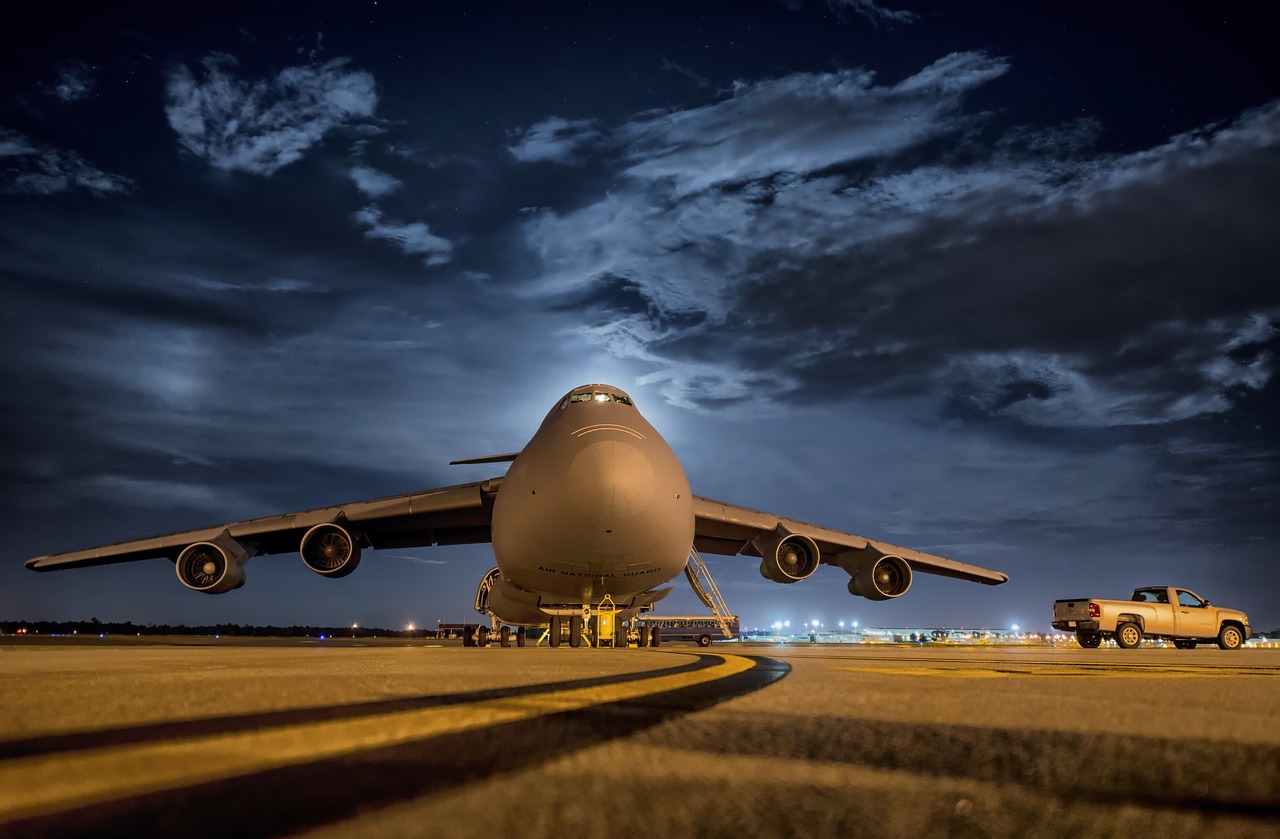
Joint Military Exercises
Joint military exercises are more than just routine training sessions; they are a vital component of modern defense strategies that foster cooperation and enhance readiness among allied nations. These exercises serve as a platform for countries to come together, share their military capabilities, and strengthen their collective response to emerging security threats. Imagine a symphony orchestra where each musician plays their part harmoniously; similarly, joint military exercises ensure that each nation’s forces can operate seamlessly in unison when the need arises.
The benefits of joint military exercises are manifold. Firstly, they allow for the testing and evaluation of tactics, techniques, and procedures in real-world scenarios. This hands-on experience is invaluable, as it provides insights that theoretical training cannot. For instance, during these exercises, forces can identify operational strengths and weaknesses, adjust strategies, and refine their coordination. Moreover, these exercises help build trust and understanding among allied forces, which is crucial in times of crisis.
In addition to enhancing military readiness, joint exercises also serve as a deterrent to potential aggressors. When countries demonstrate their capability to work together effectively, it sends a strong message that they are prepared to defend their interests collectively. This display of unity can often prevent conflicts from escalating. For example, recent multinational exercises in the Pacific region have showcased the commitment of allied nations to maintain stability in the face of growing tensions.
To illustrate the scope and impact of joint military exercises, consider the following table that highlights some notable exercises conducted in recent years:
| Exercise Name | Participating Countries | Objectives | Location | Date |
|---|---|---|---|---|
| Operation Pacific Shield | USA, Japan, Australia | Maritime Security and Disaster Response | Pacific Ocean | August 2022 |
| Exercise Saber Strike | USA, Estonia, Latvia, Lithuania | Land Force Readiness and Interoperability | Baltic States | June 2023 |
| Joint Warrior | UK, NATO Allies | Combined Air and Maritime Operations | Scotland | October 2023 |
In conclusion, joint military exercises are essential for developing a robust defense posture among allied nations. They not only enhance operational capabilities but also strengthen diplomatic ties, ensuring that countries are better equipped to face any challenges that may arise. By investing in these collaborative efforts, nations can create a more secure global environment, emphasizing the importance of unity in the face of adversity.
- What are joint military exercises?
Joint military exercises are collaborative training operations conducted by allied nations to improve interoperability, readiness, and strategic coordination in response to potential threats.
- Why are joint military exercises important?
They enhance military readiness, build trust among allied forces, and serve as a deterrent to potential aggressors by demonstrating collective strength.
- How often do these exercises occur?
The frequency of joint military exercises varies by region and participating countries, but they are typically conducted annually or biannually to maintain readiness.
- What types of scenarios do these exercises simulate?
Exercises can simulate a range of scenarios, including conventional warfare, counter-terrorism operations, humanitarian assistance, and disaster relief efforts.

Intelligence Sharing Initiatives
In today's interconnected world, have become a cornerstone of global security strategies. Nations are increasingly recognizing that the complexities of modern threats—ranging from terrorism to cyber espionage—require collaboration and information exchange to effectively counteract them. Imagine a puzzle where each piece represents vital information held by different countries; only by fitting these pieces together can we see the larger picture of global security.
These initiatives often involve formal agreements between nations, allowing them to share intelligence related to threat assessments, operational tactics, and emerging risks. For example, NATO has established frameworks for intelligence sharing among its member states, enhancing their collective defense posture. Such collaborations ensure that nations are not only aware of potential threats but also equipped with the necessary insights to respond swiftly.
Moreover, intelligence sharing is not limited to military alliances. Countries are increasingly engaging in bilateral and multilateral partnerships to enhance their security capabilities. For instance, the Five Eyes alliance—comprising Australia, Canada, New Zealand, the United Kingdom, and the United States—serves as a prime example of how countries can pool their resources and expertise to combat shared threats. This alliance facilitates the exchange of signals intelligence, allowing member nations to monitor and respond to threats more effectively.
However, successful intelligence sharing goes beyond mere information transfer. It requires trust, transparency, and a commitment to protecting sensitive data. Countries must navigate the delicate balance between sharing critical information and safeguarding national security interests. This is where secure communication channels and advanced encryption technologies play a vital role, ensuring that shared intelligence remains confidential and is only accessible to authorized personnel.
Additionally, joint training programs are often implemented to enhance the effectiveness of intelligence sharing. By conducting exercises that simulate real-world scenarios, nations can practice how to share and utilize intelligence in a cohesive manner. This not only improves operational readiness but also fosters relationships among intelligence agencies, paving the way for smoother collaboration in times of crisis.
In conclusion, intelligence sharing initiatives are not just a trend; they are a necessity in the fight against contemporary security challenges. As threats evolve, so too must our strategies for addressing them. By fostering international cooperation and leveraging shared intelligence, nations can enhance their defense capabilities and work towards a safer global environment.
- What are intelligence sharing initiatives? Intelligence sharing initiatives are collaborative efforts between nations to exchange information related to security threats, enhancing collective defense capabilities.
- Why is intelligence sharing important? It allows countries to pool resources, anticipate threats, and respond more effectively to security challenges, ultimately improving global safety.
- How do countries ensure the security of shared intelligence? Countries implement secure communication channels and advanced encryption technologies to protect sensitive information during sharing.
- What is the Five Eyes alliance? The Five Eyes alliance is a cooperative intelligence-sharing arrangement among Australia, Canada, New Zealand, the United Kingdom, and the United States, focusing on signals intelligence.
- Are there risks associated with intelligence sharing? Yes, there are risks, including the potential for sensitive information to be leaked or misused, which necessitates careful management and trust between participating nations.

Challenges and Limitations
Despite the remarkable advancements in advanced defense systems, they are not without their . As nations strive to enhance their military capabilities, they face several hurdles that can hinder progress and effectiveness. One of the most significant challenges is budget constraints. Defense budgets are often scrutinized, and governments must make tough decisions on where to allocate resources. This can lead to prioritizing certain programs over others, potentially leaving critical areas of national security underfunded. For instance, while investing in cutting-edge technologies like artificial intelligence and drone systems is essential, it may come at the expense of traditional defense capabilities that are equally vital.
Moreover, the rapid pace of technological change presents another hurdle. As new threats emerge, the defense sector must continuously adapt and innovate. However, this can be a daunting task, especially when considering the technological limitations that still exist. For example, while autonomous systems like drones are becoming more prevalent, they still face challenges related to reliability, security, and operational effectiveness in complex environments. These limitations can hinder their deployment and effectiveness in real-world scenarios.
Another critical aspect to consider is the ethical implications surrounding the use of advanced technologies in defense. The rise of autonomous weapons and surveillance systems raises profound questions about human rights and international law. For instance, how do we ensure accountability in the event of a malfunction or unintended consequences of an autonomous system? These ethical dilemmas necessitate a careful examination of the implications of deploying such technologies. It’s essential to strike a balance between leveraging technological advancements for national security and upholding ethical standards that protect human rights.
In summary, while advanced defense systems offer innovative solutions to emerging security challenges, they are accompanied by notable challenges that must be addressed. From budget constraints to ethical considerations, understanding these limitations is crucial for shaping effective defense strategies in the future. As nations navigate these complexities, collaboration and thoughtful discourse will be essential in ensuring that advancements in defense technology align with broader societal values and security needs.
- What are the main challenges facing advanced defense systems?
Advanced defense systems face budget constraints, technological limitations, and ethical considerations that can impact their effectiveness and implementation. - How do budget constraints affect defense technology development?
Budget constraints can lead governments to prioritize certain defense programs over others, potentially leaving critical areas of national security underfunded. - What ethical issues are associated with autonomous weapons?
The use of autonomous weapons raises questions about accountability, human rights, and the potential for unintended consequences in military operations.

Budget Constraints
When it comes to advanced defense systems, are like a double-edged sword. On one hand, they dictate how much a nation can invest in cutting-edge technologies; on the other hand, they can significantly impact national security. Imagine trying to build a fortress with a limited supply of bricks—each decision becomes crucial, and some areas may end up neglected. This is the reality for many governments as they navigate the complex landscape of defense funding.
Many countries find themselves grappling with competing priorities. For instance, while a nation may want to invest in artificial intelligence and cybersecurity, it also must address pressing issues like healthcare and education. The challenge lies in balancing these needs without compromising the safety of the nation. Often, defense budgets are stretched thin, leading to difficult choices about which technologies to prioritize. This situation can leave gaps in defense capabilities, making nations vulnerable to emerging threats.
Additionally, the rapid pace of technological advancement means that what is cutting-edge today may be obsolete tomorrow. As a result, governments must be agile in their funding strategies. They need to not only invest in current technologies but also anticipate future needs. This requires a level of foresight and flexibility that many budgets simply do not allow. For example, consider the following table that illustrates the allocation of defense budgets among various sectors:
| Sector | Percentage of Budget |
|---|---|
| Personnel and Training | 35% |
| Research and Development | 25% |
| Equipment and Technology | 20% |
| Operations and Maintenance | 15% |
| Other | 5% |
This table highlights how funds are distributed across various sectors, revealing that while research and development are crucial, they often compete with immediate operational needs. As nations face budget constraints, they must make tough decisions about where to allocate resources. This can lead to a reliance on outdated technologies, which can be a significant disadvantage in a rapidly evolving security landscape.
Moreover, the political climate can further complicate budget considerations. Defense spending often becomes a contentious issue, with differing opinions on how much should be allocated and to what areas. This can lead to delays in funding approvals and, ultimately, hinder the development of necessary technologies. In a world where threats are constantly evolving, the ability to adapt and innovate is crucial, yet budget constraints can stifle these efforts.
In conclusion, while advanced defense systems are essential for national security, pose significant challenges. Governments must navigate these limitations carefully, balancing immediate needs with long-term investments in technology. The stakes are high, and the consequences of inadequate funding can be dire, making it imperative for nations to find innovative solutions to their financial challenges.
- What are advanced defense systems? Advanced defense systems refer to a range of technologies designed to protect nations from evolving threats, including cyber attacks, terrorism, and conventional warfare.
- Why are budget constraints a challenge for defense systems? Budget constraints limit how much money can be allocated to developing and deploying advanced technologies, which can leave gaps in national security.
- How do nations prioritize their defense budgets? Nations must balance competing priorities, such as healthcare and education, while ensuring that they invest in current and future defense technologies.
- What role does international collaboration play in defense? International collaboration helps nations share intelligence, technology, and resources, enhancing collective defense capabilities against shared threats.

Ethical Considerations
The rapid advancement of defense technologies, particularly in areas like artificial intelligence and autonomous systems, raises a plethora of ethical questions that cannot be ignored. As nations invest heavily in these technologies, the implications for human rights, accountability, and international law become increasingly complex. For instance, the deployment of autonomous weapons systems, which can make life-and-death decisions without human intervention, sparks a debate about the moral responsibility for their actions. Who is to blame if an autonomous drone mistakenly targets civilians? The lack of clear accountability poses a significant ethical dilemma.
Moreover, the use of surveillance technologies in defense strategies can lead to invasive monitoring of individuals, infringing on privacy rights. While these systems are designed to enhance national security, they may also be misused for purposes beyond their intended scope, leading to potential abuses of power. This duality—where technology can either protect or violate rights—highlights the need for stringent regulations and oversight.
To illustrate the ethical landscape of advanced defense technologies, consider the following points:
- Accountability: Who is responsible for the actions of autonomous systems?
- Privacy: How do surveillance measures impact individual rights?
- Bias: Can AI systems be trusted to make unbiased decisions in high-stakes scenarios?
- International Law: How do these technologies align with existing legal frameworks governing warfare and human rights?
These questions are not merely academic; they have real-world implications that could shape the future of global security. As countries navigate these challenges, it is crucial to foster a dialogue that includes ethicists, technologists, and policymakers to develop guidelines that ensure the responsible use of advanced defense systems.
In conclusion, while the innovations in defense technology promise enhanced security, they also demand a thorough examination of the ethical considerations at play. Striking a balance between leveraging these technologies for protection and safeguarding human rights is essential for maintaining global peace and security.
- What are autonomous weapons? Autonomous weapons are systems that can operate without human intervention, making decisions about targeting and engagement.
- How do ethical considerations affect defense technology? Ethical considerations ensure that the use of technology aligns with human rights and international laws, preventing misuse and abuse.
- Why is accountability important in defense systems? Accountability is crucial to ensure that responsible parties are held liable for the actions of defense technologies, particularly in cases of unintended harm.
- What role does international law play in advanced defense systems? International law provides a framework for the acceptable use of military technologies, helping to regulate actions and promote compliance among nations.
Frequently Asked Questions
- What are advanced defense systems?
Advanced defense systems are a collection of innovative technologies and strategies designed to protect nations from a variety of evolving threats, such as cyber attacks, terrorism, and conventional warfare. They play a crucial role in maintaining national security in today's complex global landscape.
- How does artificial intelligence enhance defense systems?
Artificial intelligence (AI) significantly enhances defense systems by enabling faster decision-making processes, predictive analytics, and autonomous operations. This allows military forces to respond more effectively to emerging threats, improving overall strategic outcomes.
- What are the benefits of using drones in military operations?
Drones provide numerous benefits in military operations, including surveillance, reconnaissance, and combat capabilities. They allow for operations in dangerous environments without risking human lives, making them invaluable assets in modern warfare.
- Why is cybersecurity important in defense systems?
As cyber threats become increasingly sophisticated, robust cybersecurity measures are essential for protecting critical infrastructure and sensitive information from malicious attacks. This ensures the integrity and functionality of defense systems in the face of cyber challenges.
- How does international collaboration enhance security?
International collaboration enhances security by enabling nations to share intelligence, technology, and resources. Joint military exercises and intelligence sharing initiatives foster cooperation, ensuring that allied nations can effectively respond to shared security threats.
- What challenges do advanced defense systems face?
Advanced defense systems encounter several challenges, including budget constraints that limit development and deployment, technological limitations that hinder effectiveness, and ethical considerations regarding the use of autonomous weapons and surveillance technologies.
- What are the ethical concerns surrounding advanced defense technologies?
The use of advanced technologies in defense raises ethical questions, especially regarding autonomous weapons and surveillance. These concerns necessitate careful examination of their implications for human rights and compliance with international law.




